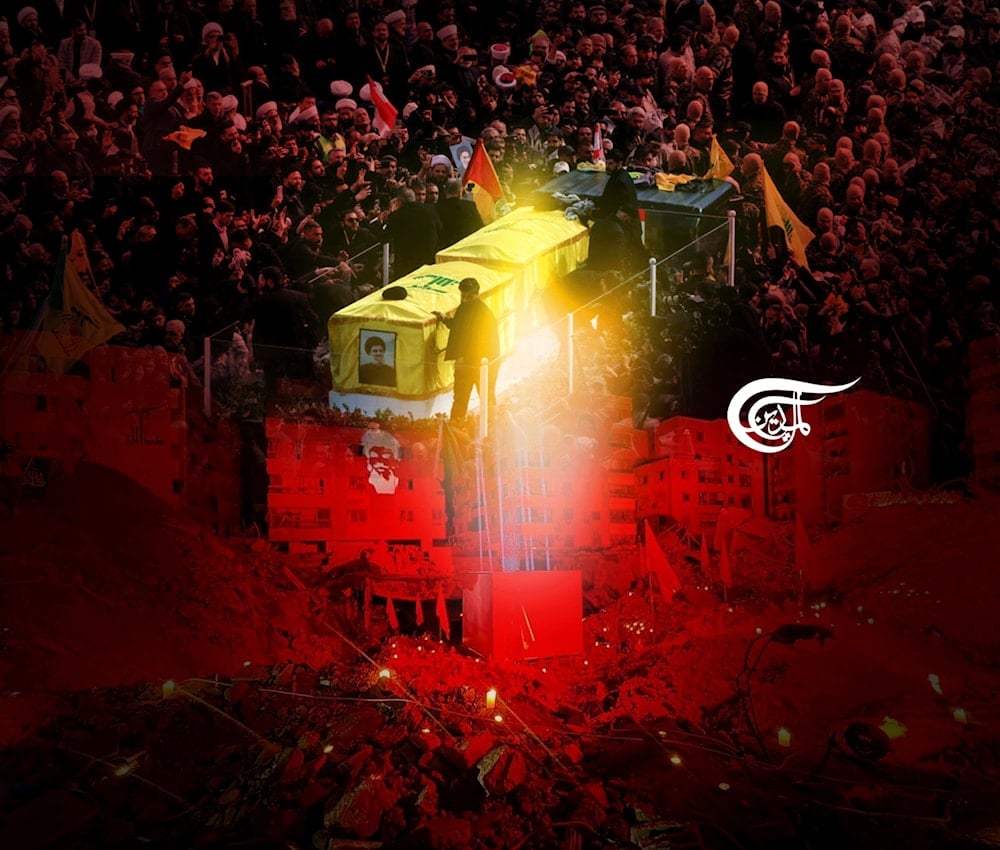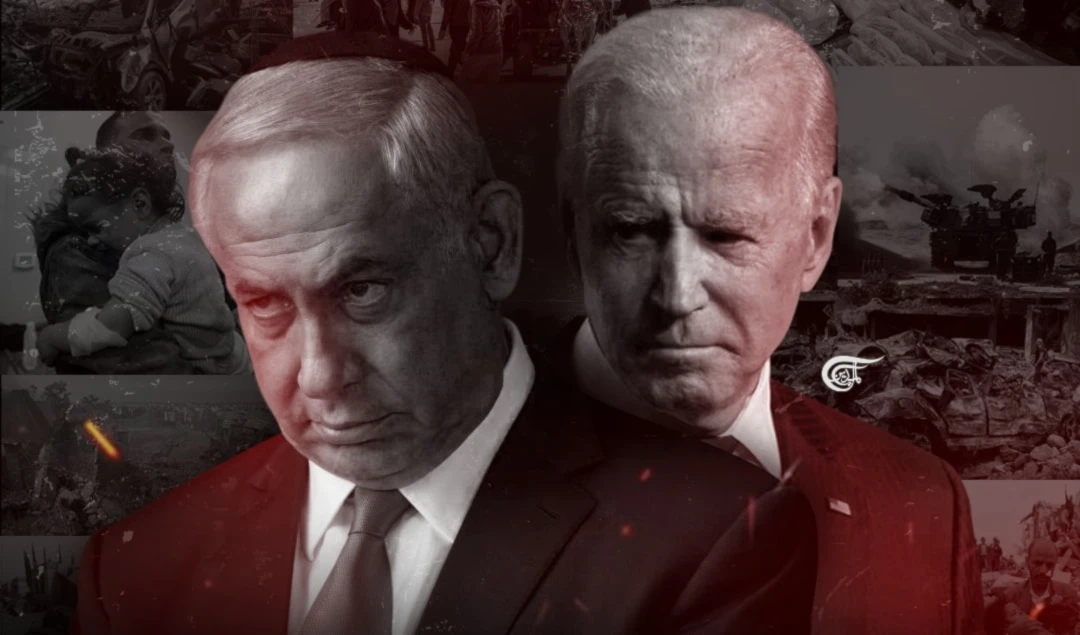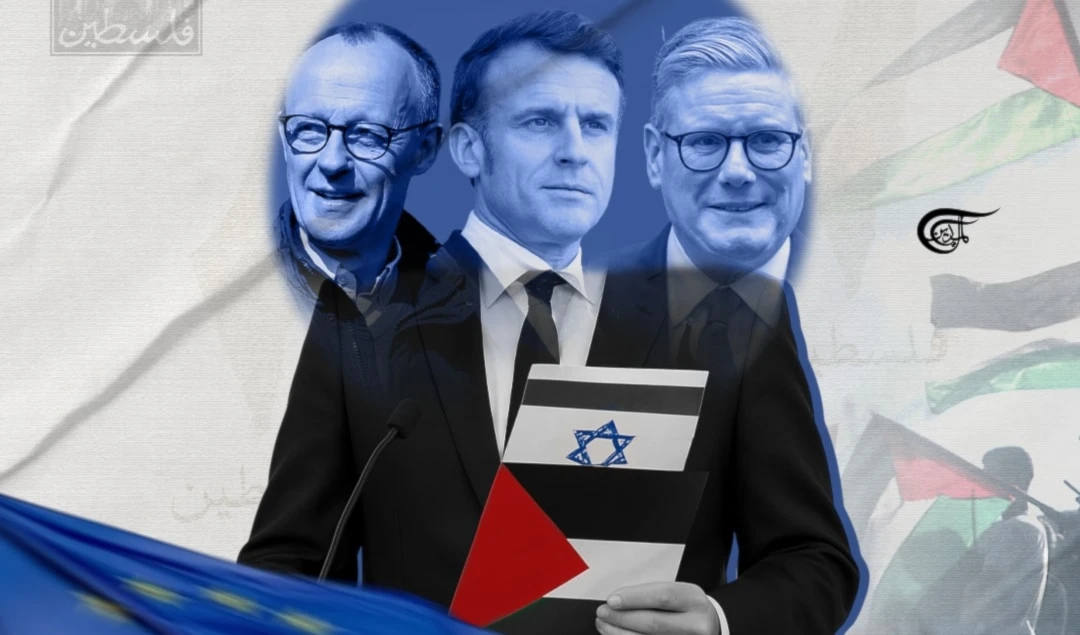Sayyed Nasrallah’s martyrdom – the fruit that bore through the rubble
Ideologically, spiritually, and institutionally, Sayyed Nasrallah built a Hezbollah that ensured a loss in leaders did not mean a loss in leadership. The Sayyed’s spirit pushes through the concrete rubble
-

The gravity of the force that they unleashed to kill one man was a testament to the weight of the figure he was (Illustrated by Mahdi Rtail; Al Mayadeen English)
It has long been emphasized by supporters of the Resistance, including Sayyed Hassan Nasrallah himself, that the Resistance is an idea that cannot be extinguished, rather, it is strengthened and grows through martyrdom.
However, we can’t deny the gravity of Sayyed Nasrallah’s loss. In his last speech, he cautioned against both aggrandizing the enemy’s power to the point of self-inflicted defeatism and underestimating the enemy.
In remembering his words of caution, it’s critical that his understanding of the enemy extends to assessing the gravity of his impact. While our faith in the Resistance and Hezbollah remains firm after his martyrdom, the aftershocks of its impacts are undeniable, an impact of a figure who was the operational leader – along with the coordinator for the whole Axis of Resistance.
As Sayyed Nasrallah’s daughter said in the latest Al Mayadeen interview, the Master of the Ummah's Martyrs educated and motivated his followers, like his family, to follow the path of righteousness and truth.
“We were never coerced into thinking a certain way,” Sayyed Nasrallah’s daughter Zeinab said, referring to her father’s parenting style which extended to his relationship with his community.
It was out of pure love and conviction that Sayyed Nasrallah’s children followed his path, and his followers trod the Holy Path out of love and loyalty and not fear. Sayyed Hassan Nasrallah was reminiscent of a leader who embodied the lessons of Imam Jaafar al-Sadiq, a popular, beloved, and charismatic leader and Imam who cautioned believers against the “slave” worship of fear and into the righteous worship of love.
The road to the liberation of al-Quds is paved with martyrdom, and, on the evening of September 27, 2024, the most precious of blood was spilled as the Zionist entity razed the Southern Suburb of Beirut through nonstop bombardment, tearing the ground amid a week-long campaign by the Zionist entity to uproot the Resistance, and especially the very leader that had given it its first taste of defeat in the ‘90s.
Nasrallah ushered in the “Era of Victories,” instilling a sense of pride and dignity in a community that had been historically marginalized and a people that internalized the defeat of Arabs in the face of “Israel” and the shame of marginalization from a deeply classist and colonized society – breaking it from his famous greetings of “ya ashraf al-nas (oh, most honorable of people)” to his people in speeches.
He himself hailed from modest beginnings – a working-class family of 10 headed by a simple fruit seller originally from Bazourieh, Tyre. He was an early disciple of Sayyed Musa al-Sadr, the original leader of the Amal revolutionary Islamic movement and an early student of Sayyed Baqir al-Sadr, traveling to Najaf, Iraq, at the age of 16 to further his Islamic studies. He was nurtured in the cradle of the growing Revolutionary Islamic movement, which culminated in the 1979 Islamic Revolution in Iran, the seeds of Revolutionary Islam planted in Lebanon years prior.
Sayyed Nasrallah showed how victory could be attained despite the modest means of those resisting the most well-funded and equipped occupations in the world, giving, for the first time, a sense of pride in a people who had spent years internalizing their own humiliation.
The Sayyed was an original leader who, in the vein of Sayyed Musa al-Sadr, fulfilled, expounded on, and furthered a legacy of the original holy sheikhs and leaders of Jabal Amel, such as Sheikh Sharafeddine, whose booming anti-colonial speech at the 1920 conference of Wadi al-Hjeir called to action an anti-colonial movement from the same valley that dealt “Israel” its “massacre of the Merkavas” in 2006.
His shrewd command of religious knowledge equipped him with the basira (deep insight) to understand society, politics, and most importantly, the enemy. In contrast to American exceptionalist understandings of the Israeli-American relationship, such as the Mearsheimian emphasis on the “Israel lobby” as the decisive, driving factor of American foreign policy, Sayyed Nasrallah kept the focus on American imperialism as the primary root of international arrogance worldwide – in line with Imam Khomeini, who identified America as the Great Satan.
Defying Western characterizations of Hezbollah or Islamic Resistance as irrational, dogmatic, or backward, Sayyed Nasrallah was a brilliant analyst and orator who spoke to many different global segments, and through his religious dimension, his analytical dimension, his role as an anti-imperialist icon, and a scholar, he garnered a global following of those who loved and revered his service to the oppressed.
While having large success in fostering a sense of national unity, Sayyed Nasrallah came under additional challenges amid the US-engineered economic crisis in Lebanon and the subsequent color revolution, where American and European-backed narratives, whether in billionaire-funded “independent” media or through NGOs, attempted to break the domestic unity coalition and replace the Lebanese government with an unelected American and World Bank technocracy, falsely pitting Sayyed Nasrallah as a supporter of corruption and Lebanon’s domestic problems. These same sponsors attempted to usher in themes and discourses of normalization in Lebanon in the template of Ukraine’s 2014 Euromaidan.
Dialectic philosophy is dictated by the unity of opposites, and the truth lies in this unity. By uniting different segments of society – Muslim and Christian, Sunni and Shiite, secular and religious, toward a common effort of national and regional sovereignty, Sayyed Hassan Nasrallah masterfully seamed together the sectarian and social fissures inflicted by ages of imperialist divide-and-conquer counterinsurgency.
The populist developmentalism of Hezbollah cemented under Sayyed Hassan Nasrallah, through credit union Qard al-Hassan that provided low-cost loans; Dar al-Hawraa, an affordable community clinic providing a wide range of services; and Jihad al-Binaa, which immediately and expediently moed on the postwar reconstruction of homes in Dahieh and the South, at a speed and efficiency that baffled civil engineers. Jihad al-Binaa also supports farming and beekeeping, including workshops, seed distribution, and technical assistance, embodying Hezbollah’s commitment to industry and agriculture as the labor-oriented backbone of building Lebanese society, a contrast to the finance-capital oriented economy that otherwise comprises Lebanese state institutions.
The US, shaken by the colossal challenge imposed by the Palestinian Resistance at the outset of Operation Al-Aqsa Flood, sought to salvage itself against the existential threat the Resistance dealt it and the Zionist entity, moving from soft power to hard war tactics to enforce (and force) their consensus of normalization, which Sayyed Nasrallah spent his life to fight and keep out of Lebanon. Referring to the Camp David Accords in speeches, Sayyed Nasrallah articulated a structuralist understanding of the relationship between normalization, neoliberalism, and what he always referred to as an “imposition of a humiliating political process on the Palestinians and Arabs,” under the guise of empty promises of political stability and prosperity that otherwise ushered in further pauperization of population that siphoned state assets for US financial capital, enriching itself and the Washington-aligned comprador class.
To impose this very political reality on Lebanon, the Zionist entity bombed – over 80 times – the apartment buildings over Sayyed Nasrallah with American Mark 84 multi-ton bombs. The gravity of the force that they unleashed to kill one man was a testament to the weight of the figure he was, and despite the damage meant to turn mountains into craters - with bombs known to evaporate bodies - Sayyed Nasrallah’s martyred body remained intact.
Ideologically, spiritually, and institutionally, Sayyed Nasrallah built a Hezbollah that ensured a loss in leaders did not mean a loss in leadership. The Sayyed’s spirit pushes through the concrete rubble, where the fruits of Resistance naturally bear through a history of siege and martyrdom. Mourners are arriving, putting their personal lives on hold or politically motivated obstacles in transit to attend the funeral of a leader matched by so few in his impact and level of resonance worldwide. Millions came to attend the funeral of the man who changed the world, challenged Israeli and American arrogance, and won the hearts of millions. Where “Israel” tries to bury a martyr, a thousand more warriors and followers rise from the rubble – from the ideological and spiritual seeds Sayyed Nasrallah planted.
With Sayyed [Nasrallah's] planning, Hezbollah grew step by step, patiently, logically, and naturally [...showing] the effect of its existence on enemies in different stages: ‘a pure being like an immaculate tree whose roots are firm in the ground and whose branches are in heavens, yielding fruit in every season by permission of its Lord? Allah draws such comparisons for men so that they may take heed" (Quran 14:25) - Sayyed Khamenei.

 Julia Kassem
Julia Kassem
 8 Min Read
8 Min Read











